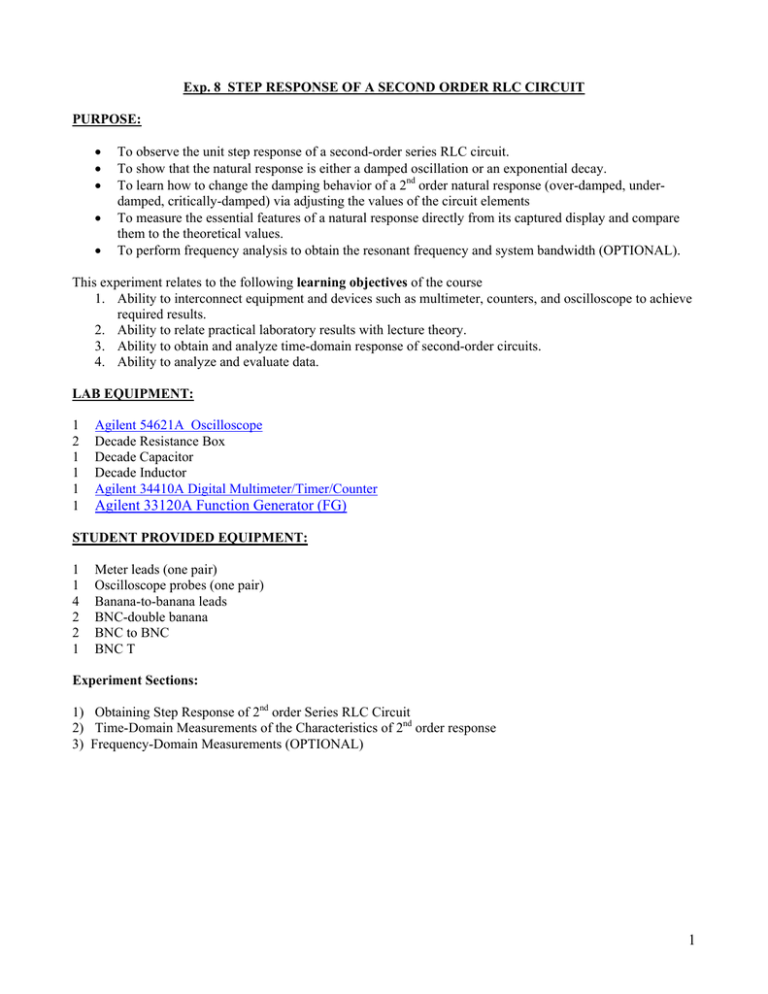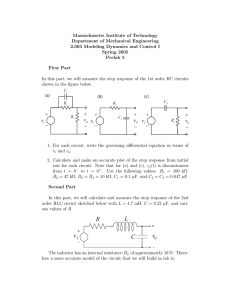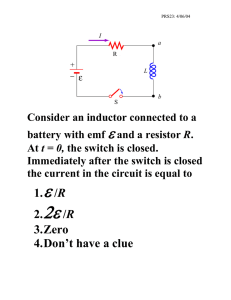Again, this equation is valid only in the underdamped case, i
advertisement

Exp. 8 STEP RESPONSE OF A SECOND ORDER RLC CIRCUIT PURPOSE: • • • • • To observe the unit step response of a second-order series RLC circuit. To show that the natural response is either a damped oscillation or an exponential decay. To learn how to change the damping behavior of a 2nd order natural response (over-damped, underdamped, critically-damped) via adjusting the values of the circuit elements To measure the essential features of a natural response directly from its captured display and compare them to the theoretical values. To perform frequency analysis to obtain the resonant frequency and system bandwidth (OPTIONAL). This experiment relates to the following learning objectives of the course 1. Ability to interconnect equipment and devices such as multimeter, counters, and oscilloscope to achieve required results. 2. Ability to relate practical laboratory results with lecture theory. 3. Ability to obtain and analyze time-domain response of second-order circuits. 4. Ability to analyze and evaluate data. LAB EQUIPMENT: 1 2 1 1 1 1 Agilent 54621A Oscilloscope Decade Resistance Box Decade Capacitor Decade Inductor Agilent 34410A Digital Multimeter/Timer/Counter Agilent 33120A Function Generator (FG) STUDENT PROVIDED EQUIPMENT: 1 1 4 2 2 1 Meter leads (one pair) Oscilloscope probes (one pair) Banana-to-banana leads BNC-double banana BNC to BNC BNC T Experiment Sections: 1) Obtaining Step Response of 2nd order Series RLC Circuit 2) Time-Domain Measurements of the Characteristics of 2nd order response 3) Frequency-Domain Measurements (OPTIONAL) 1 Section 1, Obtaining Step Response of 2nd Order Series RLC Circuit a) Set up the circuit shown. Use resistor, inductor and capacitor decade boxes for R, L, and C, respectively. Set L = 100 mH, and C = 0.01 µF. Using the multimeter, measure and record the parasitic resistance of the inductor (depending on the inductor, it should be in the range of 4 -15Ω). RTh represents the finite output resistance of the function generator (about 50 Ω). Place the FG output termination to “HIGH Z” and set it to produce a 2V peak to peak square wave with a period of 10 ms (frequency of 100 Hz) and no DC offset. Function Generator Inductor RTH R Rp L + C C vo - b) Set the resistor decade box to R = 1kΩ and monitor the input and output voltage waveforms of the circuit using the channels one and two of the oscilloscope, respectively. You should observe that the circuit is under-damped. Adjust the scope settings as appropriate to expand and clearly reveal the oscillation (ringing). Capture the scope’s display and include a copy of it in your report. c) Set the resistor decade box to R = 7kΩ. The circuit should now be over-damped. Adjust the scope settings appropriately to reveal the damped natural response. Include the response in your report. d) Change the value of the resistor box R to obtain the resistance Rx at which the response is criticallydamped. Your response will be critically-damped when a slight change in R produces ringing in the response. Note that you may have a response that exhibits an overshoot but not ringing. Record the value of R that that produces the critically-damped response and copy the response in your report. Question: Section 1 1) In step (c) above, what is the percent difference between the value of R’c = Rx + RTH + RP and the calculated value Rc obtained in the prelab? Justify the difference. Section 2) Time-Domain Measurements of the Characteristics of 2nd order response Note: In the following steps you will measure certain features of the natural response by making direct measurements from displays on the scope. For most parts, you will be using the “cursors” utility of the scope to make these measurements. To make accurate measurements, it is recommended that you enlarge the region of the waveform needed for your measurement. In addition, it is best to lower the intensity of the display to make the plot thinner and hence easier to read its intersection with the cursor lines. 2 a) For the under–damped response, measure the step response overshoot using the equation: Percent Overshoot = 100 x [Vmax - V(∞ ) ] / V(∞ ) Use scope’s “overshoot” softkey (accessible in “quick meas” mode) to read the percent overshoot and compare it with the value you obtained using the above formula. b) Determine the frequency of oscillation (damped frequency ωd ) by measuring the period of oscillation as shown in the figure above. Note that once you set the scope cursors to read the period ∆t, it will also display the frequency f =1/∆t. c) One way to verify that the output responses obtained in the previous section represent the solution to the second-order differential equations that describe them is to compare the measured time constants of the output responses to their calculated values. For the over-damped and critically-damped cases, direct measurement of the time constant from the response is feasible only under certain conditions (see questions 3 and 4 in this section). Here, we will only measure the time constant for the under-damped case. –t/τ The time constant of an exponential decay of the form Ae is the time required for the decay to reach 1/e of its maximum (i.e., A/e). As shown in the diagram above, for the under-damped case the envelope of the oscillation is an exponential decay that can be modeled as: –t/τ Env (t) = V(∞ ) + [ A - V(∞ )] e where Env (t) A= Env(0) V(∞ )= Env(∞) Envelope of oscillation for under-damped case Initial value ( a constant) Final value 3 τ Time constant By measuring two point (t1, v1) and (t2, v2) on the Env ( t ) curve, we can calculate the time constant τ from the following formula: (assuming t2 > t1) : - Note that it is advisable to choose the two points (t1, v1) and (t2, v2) far from each other in order to increase the accuracy of measurement of τ . For this case, it is advisable that you select t1 and t2 to correspond to first and third peaks of oscillation. Questions: Section 2 1) What is the percent difference between the measured value of the damping frequency ωd in step (b) above and the calculated value obtained in the prelab? Explain the reasons for the difference. 2) Construct a table showing the calculated (prelab) and measured value of the time constant, and the percent difference between the two. Explain the reasons for any difference. 3) Derive the equation for time constant τ in step (c) above. Hint: plug each of the two data points (t1, v1) and –t/τ (t2, v2) in the envelope function Env (t) = V(∞ ) + [ A - V(∞ )] e to form two equations. Divide one equation by the other (side by side), simplify, take the natural log of the result, and solve for τ. 4) As you read in the narrative section of this experiment, the over-damped response is actually the sum of two exponentials having different time constants τ1 and τ2 , i.e., - t/τ 1 v(t) = k1 e - t/τ 2 + k2 e + v (∞) –t/τ1 –t/τ2 term goes to zero sooner than e ), prove that we Assuming that τ2 is greater than τ1 (that is, the e can still use the equation in part (c) above to calculate the larger of the two time constants τ1 and τ2 . Hint: use the hint in question 3 to derive the equation for τ2 . 5) As you read in the narrative section of this experiment, the critically-damped response is of the form –t/τ (k1 + k2 t ) e . Describe under what condition, we can still use the formula in section (c) to approximate the single time constant τ for this case. Hint: consider the relative magnitude of the coefficients k1 and k2. Section 3) Frequency-Domain Measurements (optional) a) In the RLC circuit above, set R = 1 kΩ (under-damped case) and switch the square wave to sine wave but maintain all other settings. 4 b) Monitor the voltage across the resistor R using channel 1 of the scope. Sweep the frequency from 100 Hz to 10 kHz and observe the amplitude of the sinusoidal output. The signal amplitude should first increase with increasing frequency and then decrease after the maximum is attained. Record the frequency fo at which the amplitude is maximized. This is the resonant frequency ωo=2л fo . c) Another useful parameter is the bandwidth of the system which represents the range of frequencies over which the amplitude of the current remains above 70 percent of its maximum. The maximum current occurs at resonant frequency ωo and is equal in magnitude to the amplitude of the input signal divided by the resistive component of the circuit. The current amplitude is proportional to the voltage across the resistor R in the circuit. Thus the bandwidth can be determined by varying the frequency away from fo (in both directions) until the amplitude of the voltage across the resistor R falls to 0.707 of its peak value of Imax R. These frequencies, one below and one above fo, are termed the half-power points, f1 and f2 since at the corresponding current the power absorbed by the circuit is half of its maximum. The bandwidth of the circuit is the difference between the half-power points, i.e., BW = ⎢f2 – f1⎟. Measure f1 , f2 and the bandwidth of the circuit. Questions: Section 3 1) For a series RLC circuit, the resonant frequency fo corresponds to the frequency at which the current is maximized. Do the amplitudes of the voltages across the resistor, capacitor, and the inductor also peak at fo? Explain. Hint: Remember that the voltage across and the current through a resistor are in phase but for an inductor or a capacitor the current and voltage are 90 degrees out of phase. 2) What is the percent difference between the measured value of the resonant frequency ωo = 2Π fo in step 1 above and its calculated value which you obtained in the prelab? Explain the reasons for the difference. 5




